Detection of Atrial Fibrillation Episodes in Long-Term Heart Rhythm Signals Using a Support Vector Machine
Abstract
1. Introduction
2. Materials and Methods
2.1. HR Irregularity Features
- MEDi = median{HRi−k,…,HRi+k};
- MADi = median{xi−k,…,xi+k}, where xi = |HRi−MEDi|;
- QNTi—represents the quantile of order 0.7 estimated over 21 values of heart rate;
- PRPi—is the ratio of number of HR values between thresholds level of 120 to 160 bpm, to total number.
- The mean heart rate:
- Standard deviation of instantaneous heart rate values:
- Root Mean Square of Successive Differences (RMSSD) which measures the variability within a data set—RR intervals—according to the following equation:
- Percentage of differences between the RR intervals that exceed the value of 50 ms, denoted as pNN50 [%]:where:
- Poincare graph, which is a graphical representation of the current interval RRi plotted against subsequent one RRi+1. Using the ellipse fitting technique, in each moving window comprising 21 heartbeats, two standard deviations are determined from the points: perpendicular to the regression line (SD1) and along the line (SD2). The SD1 describes the short-term variability of the heart rhythm, while the SD2 refers to the long-term HR variability.
- Turning Points Ratio (TPR) measures the randomness of fluctuations within a data set, by calculating the ratio of the number of turning points to the maximum number of possible turning points. Turning point is found if both the preceding and succeeding points are either greater or lower. It is expected in random data set of arbitrary length N, that the number of possible turning points is (2N − 4)/3, with a standard deviation of .
- The Yeh’s index (DI_Yeh) whose determination starts with calculation of the auxiliary values di representing the ratio of the difference between two successive RR intervals to their sum:Then, for the analyzed signal fragment, the DI_Yeh index is defined as the standard deviation from the obtained coefficients di:where: , N—number of beats set to 21.
- The Zugaib’s variability index (STV_Zug) has been defined as an average of the absolute values of the differences between successive Di values and their median value:where: Med—median value for the Di series, N—number of beats set to 21. The Di value represents the ratio of the absolute value of the difference between the heart intervals RR to their sum:
- The Huey’s index (STV_Huey) was defined as the sum of absolute values of differences of subsequent instantaneous HR values for which the sign of difference was changed:where:
- The definition of de Haan’s index (STI_Haan) is based on a polar coordinate system whose both axes refer to RR intervals expressed in milliseconds, and points represent the pairs of subsequent intervals (RRi−1, RRi), as shown in Figure 3. STI_Haan is determined as the interquartile range of the angles φi between the lines connecting the point with origin of the coordinate system, and the X axis, designated for subsequent periods RRi:where: i = 1, 2…N,N—number of beats.
2.2. LSVM Classifier
2.3. Performance Evaluation
2.4. Heartbeat Aggregation
2.5. Material
3. Results
3.1. LSVM Classifier Performance
- mixed two signals of the highest FS (08405) and Se (05091)—marked as the Training Data no. 2—TD2,
- TD2 with additional signal of the highest Sp (04126)—TD3,
- all the signals—TD4.
3.2. Optimal Beats Aggregation
3.3. AF Detection Performance
4. Discussion
5. Conclusions
Author Contributions
Funding
Acknowledgments
Conflicts of Interest
References
- Lau, J.K.; Lowres, N.; Neubeck, L.; Brieger, D.B.; Sy, R.W.; Galloway, C.D.; Albert, D.E.; Freedman, S.B. iPhone ECG application for community screening to detect silent atrial fibrillation: A novel technology to prevent stroke. Int. J. Cardiol. 2013, 165, 193–194. [Google Scholar] [CrossRef]
- Grond, M.; Jauss, M.; Hamann, G.; Stark, E.; Veltkamp, R.; Nabavi, D.; Horn, M.; Weimar, C.; Köhrmann, M.; Wachter, R.; et al. Improved Detection of Silent Atrial Fibrillation Using 72-Hour Holter ECG in Patients With Ischemic Stroke: A Prospective Multicenter Cohort Study. Stroke 2013, 44, 3357–3364. [Google Scholar] [CrossRef] [PubMed]
- Camm, A.J. Atrial Fibrillation and Risk. Clin. Cardiol. 2012, 35, S1–S2. [Google Scholar] [CrossRef] [PubMed]
- Moody, G. A new method for detecting atrial fibrillation using RR intervals. Comput. Cardiol. 1983, 227–230. [Google Scholar]
- Goldberger, A.L.; Amaral, L.A.; Glass, L.; Hausdorff, J.M.; Ivanov, P.C.; Mark, R.G.; Mietus, J.E.; Moody, G.B.; Peng, C.K.; Stanley, H.E. PhysioBank, PhysioToolkit, and PhysioNet: components of a new research resource for complex physiologic signals. Circulation 2000, 101, e215–e220. [Google Scholar] [CrossRef]
- The MIT-BIH Atrial Fibrillation Database–PhysioNet. Available online: https://physionet.org/physiobank/database/afdb/ (accessed on 20 May 2018).
- Fitzmaurice, D.A.; Hobbs, F.R.; Jowett, S.; Mant, J.; Murray, E.T.; Holder, R.; Raftery, J.P.; Bryan, S.; Davies, M.; Lip, G.Y. Screening versus routine practice in detection of atrial fibrillation in patients aged 65 or over: Cluster randomised controlled trial. BMJ 2007, 335, 383. [Google Scholar] [CrossRef]
- Rawenwaaij-Arts, C.; Kallee, L.; Hopman, J. Task Force of the European Society of Cardiology and the North American Society of Pacing and Electrophysiology. Heart rate variability. Standards of measurement, physiologic interpretation, and clinical use. Circulation 1996; 93: 1043–1065. Intern. Med. 1993, 118, 436–447. [Google Scholar]
- Desteghe, L.; Raymaekers, Z.; Lutin, M.; Vijgen, J.; Dilling-Boer, D.; Koopman, P.; Schurmans, J.; Vanduynhoven, P.; Dendale, P.; Heidbuchel, H. Performance of handheld electrocardiogram devices to detect atrial fibrillation in a cardiology and geriatric ward setting. Ep Europace 2016, 19, 29–39. [Google Scholar]
- Haberman, Z.C.; Jahn, R.T.; Bose, R.; Tun, H.; Shinbane, J.S.; Doshi, R.N.; Chang, P.M.; Saxon, L.A. Wireless Smartphone ECG Enables Large-Scale Screening in Diverse Populations. J. Cardiovasc. Electrophysiol. 2015, 26, 520–526. [Google Scholar] [CrossRef]
- Lee, J.; Reyes, B.A.; McManus, D.D.; Maitas, O.; Chon, K.H. Atrial fibrillation detection using an iPhone 4S. IEEE Trans. Biomed. Eng. 2012, 60, 203–206. [Google Scholar] [CrossRef]
- Vaid, J.; Poh, M.Z.; Saleh, A.; Kalantarian, S.; Poh, Y.K.C.; Rafael, A.; Ruskin, J. Diagnostic accuracy of a novel mobile application (Cardiio Rhythm) for detecting atrial fibrillation. J. American Coll. Cardiol. 2015, 65, A361. [Google Scholar] [CrossRef]
- Glotzer, T.V.; Hellkamp, A.S.; Zimmerman, J.; Sweeney, M.O.; Yee, R.; Marinchak, R.; Cook, J.; Paraschos, A.; Love, J.; Radoslavich, G.; et al. Atrial high rate episodes detected by pacemaker diagnostics predict death and stroke: report of the Atrial Diagnostics Ancillary Study of the MOde Selection Trial (MOST). Circulation 2003, 107, 1614–1619. [Google Scholar] [CrossRef] [PubMed]
- Hindricks, G.; Pokushalov, E.; Urban, L.; Táborský, M.; Kuck, K.-H.; Lebedev, D.; Rieger, G.; Pürerfellner, H.; on behalf of the XPECT Trial Investigators. Performance of a New Leadless Implantable Cardiac Monitor in Detecting and Quantifying Atrial Fibrillation Results of the XPECT Trial. Circ. Arrhythmia Electrophysiol. 2010, 3, 141–147. [Google Scholar] [CrossRef]
- Lake, D.E.; Moorman, J.R. Accurate estimation of entropy in very short physiological time series: the problem of atrial fibrillation detection in implanted ventricular devices. Am. J. Physiol. Circ. Physiol. 2011, 300, H319–H325. [Google Scholar] [CrossRef] [PubMed]
- Babaeizadeh, S.; Gregg, R.E.; Helfenbein, E.D.; Lindauer, J.M.; Zhou, S.H. Improvements in atrial fibrillation detection for real-time monitoring. J. Electrocardiol. 2009, 42, 522–526. [Google Scholar] [CrossRef] [PubMed]
- Christov, G.B.I. Automatic detection of atrial fibrillation and flutter by wave rectification method. J. Med. Eng. Technol. 2001, 25, 217–221. [Google Scholar] [CrossRef]
- Christov, I.; Bortolan, G.; Daskalov, I. Sequential analysis for automatic detection of atrial fibrillation and flutter. Comput. Cardiol. 2001, 28, 293–296. [Google Scholar]
- Hindricks, G.; Piorkowski, C. Atrial fibrillation monitoring: mathematics meets real life. Circulatory 2012, 126, 791–802. [Google Scholar] [CrossRef][Green Version]
- Hargittai, S. Is it possible to detect atrial fibrillation by simply using RR intervals? Comput. Cardiol. 2014, 41, 897–900. [Google Scholar]
- Slocum, J.; Sahakian, A.; Swiryn, S. Diagnosis of atrial fibrillation from surface electrocardiograms based on computer-detected atrial activity. J. Electrocardiol. 1992, 25, 1–8. [Google Scholar] [CrossRef]
- Bonomi, A.; Schipper, F.; Eerikainen, L.; Margarito, J.; Aarts, R.; Babaeizadeh, S.; De Morree, H.; Dekker, L. Atrial Fibrillation Detection Using Photo:plethysmography and Acceleration Data at the Wrist. In Proceedings of the 2016 Computing in Cardiology Conference (CinC), Vancouver, BC, Canada, 11–14 September 2016; pp. 081–339. [Google Scholar]
- Lu, S.; Zhao, H.; Ju, K.; Shin, K.; Lee, M.; Shelley, K.; Chon, K.H. Can photoplethysmography variability serve as an alternative approach to obtain heart rate variability information? J. Clin. Monit. Comput. 2008, 22, 23–29. [Google Scholar] [CrossRef] [PubMed]
- Tamura, T.; Maeda, Y.; Sekine, M.; Yoshida, M. Wearable Photoplethysmographic Sensors—Past and Present. Electronics 2014, 3, 282–302. [Google Scholar] [CrossRef]
- Hurnanen, T.; Lehtonen, E.; Tadi, M.J.; Kuusela, T.; Kiviniemi, T.; Saraste, A.; Vasankari, T.; Airaksinen, J.; Koivisto, T.; Pankaala, M. Automated Detection of Atrial Fibrillation Based on Time–Frequency Analysis of Seismocardiograms. IEEE J. Biomed. Heal. Inform. 2017, 21, 1233–1241. [Google Scholar] [CrossRef] [PubMed]
- Wrobel, J.; Jezewski, J.; Horoba, K.; Pawlak, A.; Czabanski, R.; Jezewski, M.; Porwik, P. Medical Cyber-Physical System for Home Telecare of High-Risk Pregnancy: Design Challenges and Requirements. J. Med. Imaging Heal. Inform. 2015, 5, 1295–1301. [Google Scholar] [CrossRef]
- Jezewski, J.; Pawlak, A.; Horoba, K.; Wrobel, J.; Czabanski, R.; Jezewski, M. Selected design issues of the medical cyber-physical system for telemonitoring pregnancy at home. Microprocess. Microsyst. 2016, 46, 35–43. [Google Scholar] [CrossRef]
- Roj, D.; Matonia, A.; Sobotnicka, E.; Wrobel, J. Hardware design issues and functional requirements for smart wristband monitor of silent atrial fibrillation. In Proceedings of the 2017 MIXDES—24th International Conference “Mixed Design of Integrated Circuits and Systems”, Bydgoszcz, Poland, 22–24 June 2017; pp. 596–600. [Google Scholar]
- Logan, B.; Healey, J. Robust detection of atrial fibrillation for a long term telemonitoring system. Comput. Cardiol. 2005, 32, 619–622. [Google Scholar]
- Islam, S.; Ammour, N.; Alajlan, N.; Aboalsamh, H. Rhythm-based heartbeat duration normalization for atrial fibrillation detection. Comput. Boil. Med. 2016, 72, 160–169. [Google Scholar] [CrossRef]
- Ghodrati, A.; Murray, B.; Marinello, S. RR interval analysis for detection of Atrial Fibrillation in ECG monitors. In Proceedings of the 2008 30th Annual International Conference of the IEEE Engineering in Medicine and Biology Society, Vancouver, BC, Canada, 20–24 August 2008; pp. 601–604. [Google Scholar]
- Kennedy, A.; Finlay, D.D.; Guldenring, D.; Bond, R.R.; Moran, K.; McLaughlin, J. Automated detection of atrial fibrillation using R-R intervals and multivariate-based classification. J. Electrocardiol. 2016, 49, 871–876. [Google Scholar] [CrossRef]
- Tateno, K.; Glass, L. Automatic detection of atrial fibrillation using the coefficient of variation and density histograms of RR and ΔRR intervals. Med. Boil. Eng. 2001, 39, 664–671. [Google Scholar] [CrossRef]
- Petrucci, E.; Balian, V.; Filippini, G.; Mainardi, L. Atrial fibrillation detection algorithms for very long term ECG monitoring. Comput. Cardiol. 2005, 32, 623–626. [Google Scholar]
- Lian, J.; Wang, L.; Muessig, D. A Simple Method to Detect Atrial Fibrillation Using RR Intervals. Am. J. Cardiol. 2011, 107, 1494–1497. [Google Scholar] [CrossRef] [PubMed]
- Zhou, X.; Ding, H.; Ung, B.; Pickwell-MacPherson, E.; Zhang, Y. Automatic online detection of atrial fibrillation based on symbolic dynamics and Shannon entropy. Biomed. Eng. Online 2014, 13, 18. [Google Scholar] [CrossRef] [PubMed]
- Cui, X.; Chang, E.; Yang, W.-H.; Jiang, B.C.; Yang, A.C.; Peng, C.-K. Automated Detection of Paroxysmal Atrial Fibrillation Using an Information-Based Similarity Approach. Entropy 2017, 19, 677. [Google Scholar] [CrossRef]
- Dash, S.; Chon, K.H.; Lu, S.; Raeder, E.A. Automatic Real Time Detection of Atrial Fibrillation. Ann. Biomed. Eng. 2009, 37, 1701–1709. [Google Scholar] [CrossRef] [PubMed]
- Andersen, R.S.; Poulsen, E.S.; Puthusserypady, S. A novel approach for automatic detection of Atrial Fibrillation based on Inter Beat Intervals and Support Vector Machine. In Proceedings of the 2017 39th Annual International Conference of the IEEE Engineering in Medicine and Biology Society (EMBC), Jeju Island, Korea, 11–15 July 2017; pp. 2039–2042. [Google Scholar]
- Nuryani, N.; Harjito, B.; Yahya, I.; Lestari, A. Atrial fibrillation detection using support vector machine. In Proceedings of the Joint International Conference on Electric Vehicular Technology and Industrial, Mechanical, Electrical and Chemical Engineering (ICEVT & IMECE), Surakarta, Indonesia, 4–5 November 2015; pp. 215–218. [Google Scholar]
- Colloca, R.; Johnson, A.E.; Mainardi, L.; Clifford, G.D. A support vector machine approach for reliable detection of atrial fibrillation events. Comput. Cardiol. 2013, 1047–1050. [Google Scholar]
- Yang, T.-F.; Devine, B.; Macfarlane, P.W. Artificial neural networks for the diagnosis of atrial fibrillation. Med. Boil. Eng. 1994, 32, 615–619. [Google Scholar] [CrossRef]
- Artis, S.G.; Mark, R.G.; Moody, G.B. Detection of atrial fibrillation using artificial neural networks. In Proceedings of the Computers in Cardiology, Venice, Italy, 23–26 September 1991; pp. 173–176. [Google Scholar]
- Petrėnas, A.; Marozas, V.; Sörnmo, L. Low-complexity detection of atrial fibrillation in continuous long-term monitoring. Comput. Boil. Med. 2015, 65, 184–191. [Google Scholar] [CrossRef]
- Andersen, R.S.; Peimankar, A.; Puthusserypady, S. A deep learning approach for real-time detection of atrial fibrillation. Expert Syst. Appl. 2019, 115, 465–473. [Google Scholar] [CrossRef]
- Faust, O.; Shenfield, A.; Kareem, M.; San, T.R.; Fujita, H.; Acharya, U.R. Automated detection of atrial fibrillation using long short-term memory network with RR interval signals. Comput. Boil. Med. 2018, 102, 327–335. [Google Scholar] [CrossRef]
- Wrobel, J.; Matonia, A.; Horoba, K.; Jezewski, J.; Czabanski, R.; Pawlak, A.; Porwik, P. Pregnancy Telemonitoring with Smart Control of Algorithms for Signal Analysis. J. Med. Imaging Heal. Inform. 2015, 5, 1302–1310. [Google Scholar] [CrossRef]
- Jezewski, J.; Horoba, K.; Roj, D.; Wrobel, J.; Kupka, T.; Matonia, A. Evaluating the fetal heart rate baseline estimation algorithms by their influence on detection of clinically important patterns. Biocybern. Biomed. Eng. 2016, 36, 562–573. [Google Scholar] [CrossRef]
- Wrobel, J.; Roj, D.; Jezewski, J.; Horoba, K.; Kupka, T.; Jezewski, M. Evaluation of the Robustness of Fetal Heart Rate Variability Measures to Low Signal Quality. J. Med. Imaging Heal. Inform. 2015, 5, 1311–1318. [Google Scholar] [CrossRef]
- Mangasarian, O.L.; Musicant, D.R. Lagrangian support vector machines. J. Mach. Learn. Res. 2001, 1, 161–177. [Google Scholar]
- Cortes, C.; Vapnik, V. Support-vector networks. Mach. Learn. 1995, 20, 273–297. [Google Scholar] [CrossRef]
- Roj, D.; Wrobel, J.; Matonia, A.; Horoba, K.; Henzel, N. Control and signal processing software embedded in smart wristband monitor of silent atrial fibrillation. In Proceedings of the 2017 MIXDES—24th International Conference “Mixed Design of Integrated Circuits and Systems”, Bydgoszcz, Poland, 22–24 June 2017; pp. 585–590. [Google Scholar]
- Wrobel, J.; Horoba, K.; Matonia, A.; Kupka, T.; Henzel, N.; Sobotnicka, E. Optimizing the Automated Detection of Atrial Fibrillation Episodes in Long-term Recording Instrumentation. In Proceedings of the 2018 25th International Conference “Mixed Design of Integrated Circuits and System” (MIXDES), Gdynia, Poland, 21–23 June 2018; pp. 460–464. [Google Scholar]
- Henzel, N.; Wrobel, J.; Horoba, K. Atrial fibrillation episodes detection based on classification of heart rate derived features. In Proceedings of the 2017 MIXDES—24th International Conference “Mixed Design of Integrated Circuits and Systems”, Bydgoszcz, Poland, 22–24 June 2017; pp. 571–576. [Google Scholar]
- Wróbel, J.; Horoba, K.; Pander, T.; Jeżewski, J.; Czabański, R. Improving fetal heart rate signal interpretation by application of myriad filtering. Biocybern. Biomed. Eng. 2013, 33, 211–221. [Google Scholar] [CrossRef]
- Jezewski, M.; Wrobel, J.; Horoba, K.; Gacek, A.; Henzel, N.; Leski, J. The Prediction of Fetal Outcome by Applying Neural Network for Evaluation of CTG Records. In Computer Recognition Systems 2. Advances in Soft Computing; Kurzynski, M., Puchala, E., Wozniak, M., Zolnierek, A., Eds.; Springer: Berlin/Heidelberg, Germany, 2007; Volume 45, pp. 532–541. [Google Scholar]
- Jezewski, J.; Wrobel, J.; Matonia, A.; Horoba, K.; Martinek, R.; Kupka, T.; Jezewski, M. Is Abdominal Fetal Electrocardiography an Alternative to Doppler Ultrasound for FHR Variability Evaluation? Front. Physiol. 2017, 8, 305. [Google Scholar] [CrossRef] [PubMed]
- Czabanski, R.; Jezewski, M.; Wrobel, J.; Horoba, K.; Jezewski, J. A Neuro-Fuzzy Approach to the Classification of Fetal Cardiotocograms. In IFMBE Proceedings of the 14th Nordic Baltic Conference on Biomedical Engineering and Medical Physics, Riga, Latvia, 16–20 June 2008; Volume 20, pp. 446–449, ISBN 978-3-540-69366-6. [Google Scholar]
- Czabański, R.; Jeżewski, J.; Horoba, K.; Jeżewski, M. Fetal state assessment using fuzzy analysis of fetal heart rate signals—Agreement with the neonatal outcome. Biocybern. Biomed. Eng. 2013, 33, 145–155. [Google Scholar] [CrossRef]
- Matonia, A.; Jezewski, J.; Kupka, T.; Horoba, K.; Wrobel, J.; Gacek, A. The influence of coincidence of fetal and maternal QRS complexes on fetal heart rate reliability. Med. Boil. Eng. 2006, 44, 393–403. [Google Scholar] [CrossRef]
- Jezewski, J.; Matonia, A.; Kupka, T.; Roj, D.; Czabanski, R. Determination of fetal heart rate from abdominal signals: Evaluation of beat-to-beat accuracy in relation to the direct fetal electrocardiogram. Biomed. Tech./Biomed. Eng. 2012, 57, 383–394. [Google Scholar] [CrossRef]
- Jezewski, M.; Czabanski, R.; Horoba, K.; Leski, J. Clustering with Pairs of Prototypes to Support Automated Assessment of the Fetal State. Appl. Artif. Intell. 2016, 30, 572–589. [Google Scholar] [CrossRef]
- Vapnik, V. Statistical Learning Theory; John Wiley & Sons: New York, NY, USA, 1998; ISBN 978-0471030034. [Google Scholar]
- Abe, S. Support Vector Machines for Pattern Classification; Springer Science and Business Media LLC: London, UK, 2010; ISBN-13: 9781849960977. [Google Scholar]
- Steinwart, I.; Christmann, A. Support Vector Machines; Springer: New York, NY, USA, 2008; ISBN 978-0-387-77242-4. [Google Scholar]
- Joachims, T. Learning to Classify Text Using Support Vector Machines—Methods, Theory, and Algorithms; Kluwer Academic Publishers: Norvell, CA, USA, 2002; ISBN 079237679X. [Google Scholar]
- Suykens, J.; Vandewalle, J. Least Squares Support Vector Machine Classifiers. Neural Process. Lett. 1999, 9, 293–300. [Google Scholar] [CrossRef]
- Tsang, I.W.; Kwok, J.T.; Cheung, P.M. Core vector machines: Fast SVM training on very large data sets. J. Mach. Learn. Res. 2005, 6, 363–392. [Google Scholar]
- Czabanski, R.; Jezewski, M.; Horoba, K.; Jezewski, J.; Leski, J. Fuzzy Analysis of Delivery Outcome Attributes for Improving the Automated Fetal State Assessment. Appl. Artif. Intell. 2016, 30, 556–571. [Google Scholar] [CrossRef]
- Jezewski, M.; Leski, J.; Czabanski, R. An Attempt to Optimize the Cardiotocographic Signal Feature Set for Fetal State Assessment. J. Med. Imaging Heal. Inform. 2015, 5, 1364–1373. [Google Scholar] [CrossRef]
- Jezewski, M.; Leski, J.M. Nonlinear Extension of the IRLS Classifier Using Clustering with Pairs of Prototypes. In Advances in Intelligent Systems and Computing; Burduk, R., Jackowski, K., Kurzynski, M., Wozniak, M., Zolnierek, A., Eds.; Springer: Cham, Switzerland; Heidelberg, Germany; New York, NY, USA, 2013; Volume 226, pp. 121–130. ISBN 978-3-319-00968-1. [Google Scholar]
- Dubitzky, W.; Granzow, M.; Berrar, D. Fundamentals of Data Mining in Genomics and Proteomics; Springer Science & Business Media: New York, NY, USA, 2007. [Google Scholar] [CrossRef]
- Picard, R.R.; Cook, R.D. Cross-validation of regression models. J. Am. Stat. Assoc. 1984, 79, 575–583. [Google Scholar] [CrossRef]
- Huang, C.; Ye, S.; Chen, H.; Li, D.; He, F.; Tu, Y. A novel method for detection of the transition between atrial fibrillation and sinus rhythm. IEEE Trans. Biomed. Eng. 2010, 58, 1113–1119. [Google Scholar] [CrossRef]
- Zhou, X.; Ding, H.; Wu, W.; Zhang, Y. A Real-Time Atrial Fibrillation Detection Algorithm Based on the Instantaneous State of Heart Rate. PLoS ONE 2015, 10, e0136544. [Google Scholar] [CrossRef]
- Kumar, M.; Pachori, R.B.; Acharya, U.R. Automated diagnosis of atrial fibrillation ECG signals using entropy features extracted from flexible analytic wavelet transform. Biocybern. Biomed. Eng. 2018, 38, 564–573. [Google Scholar] [CrossRef]
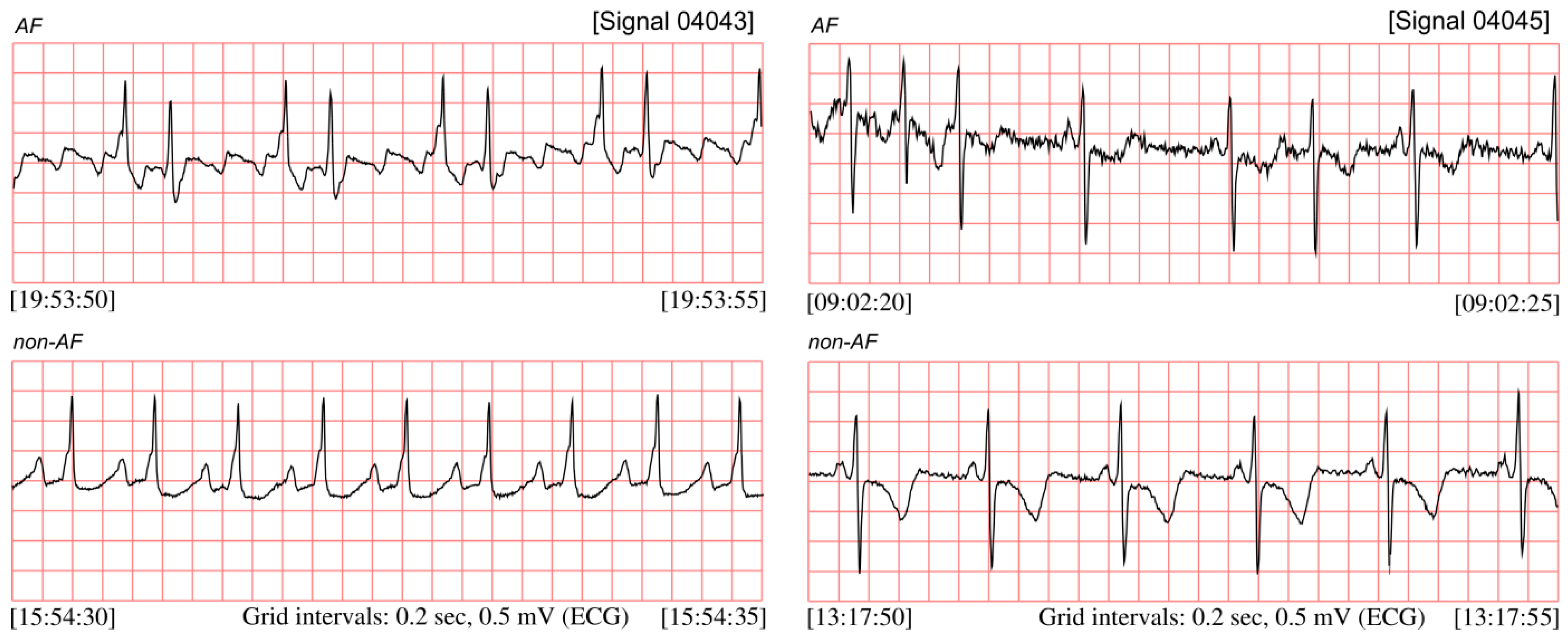
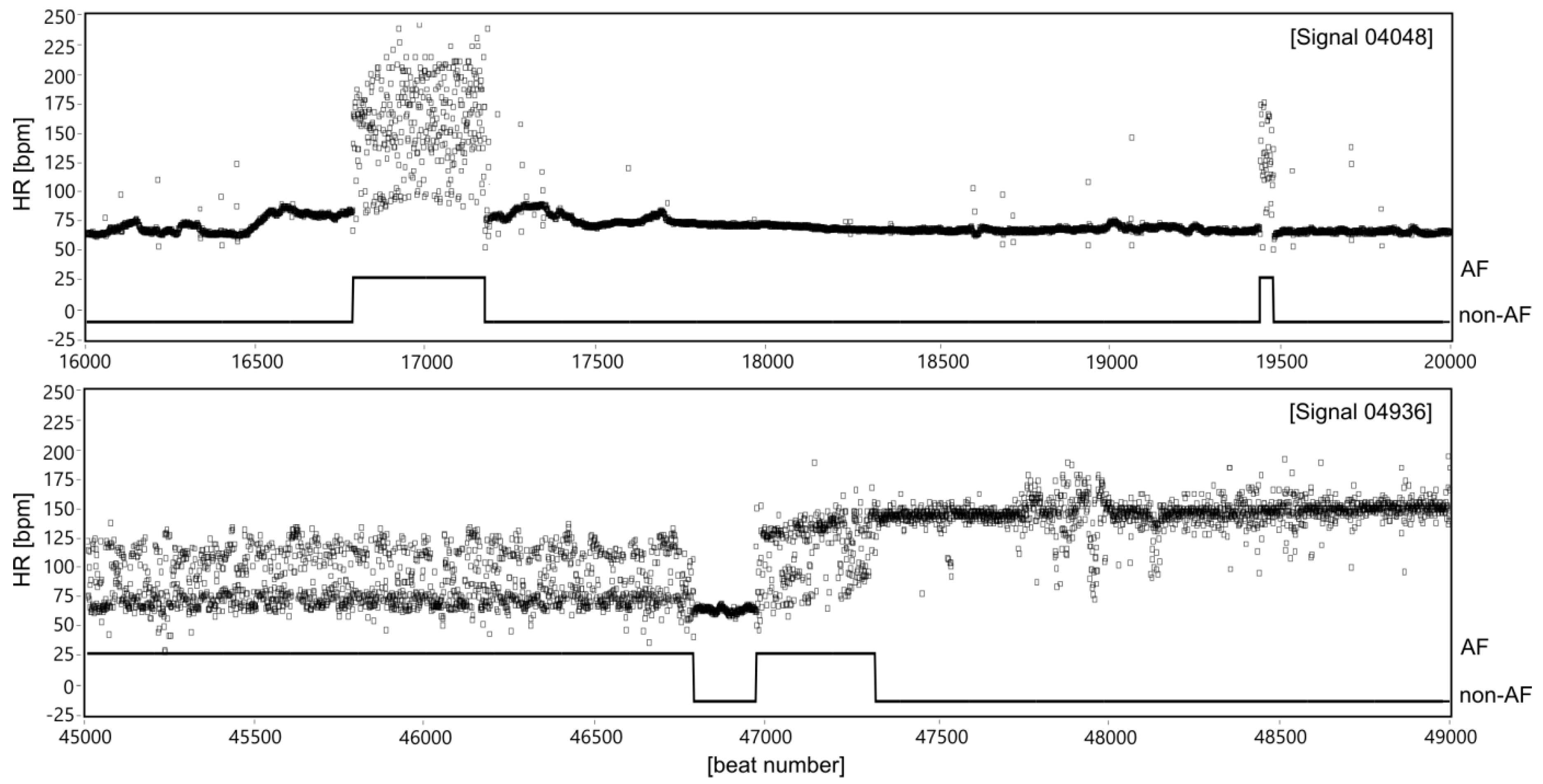
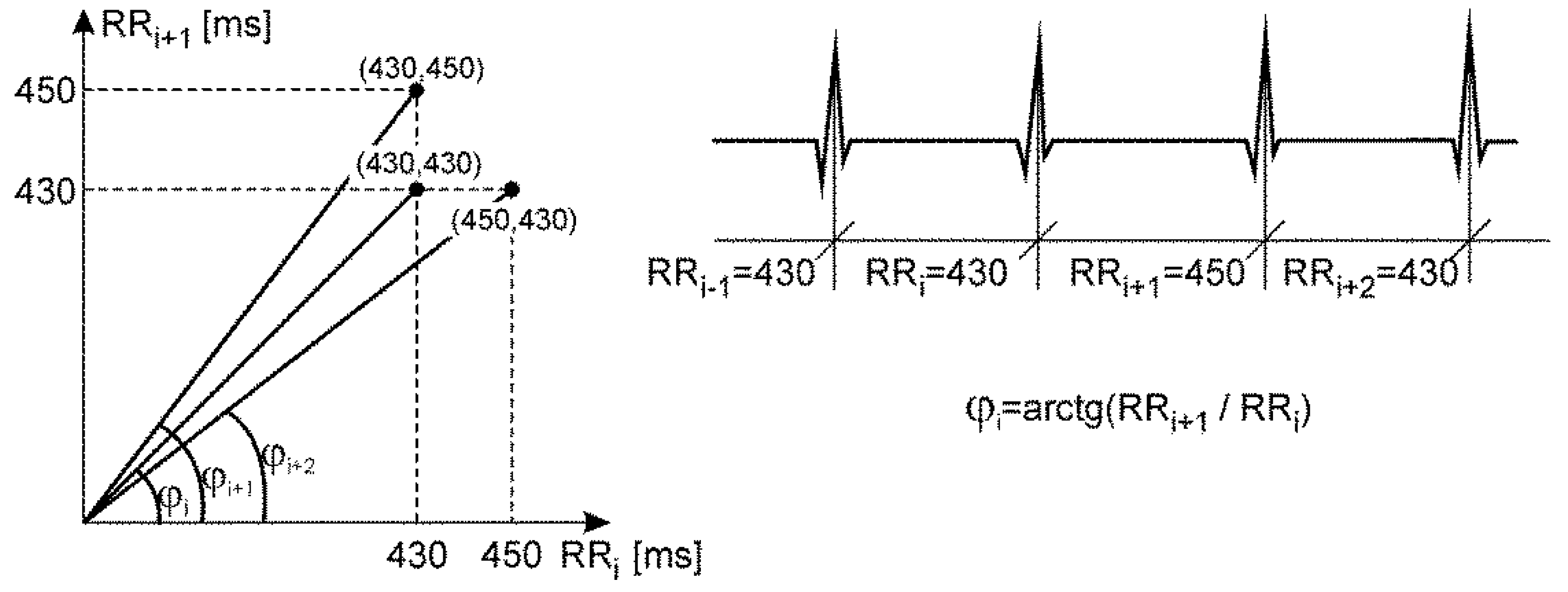
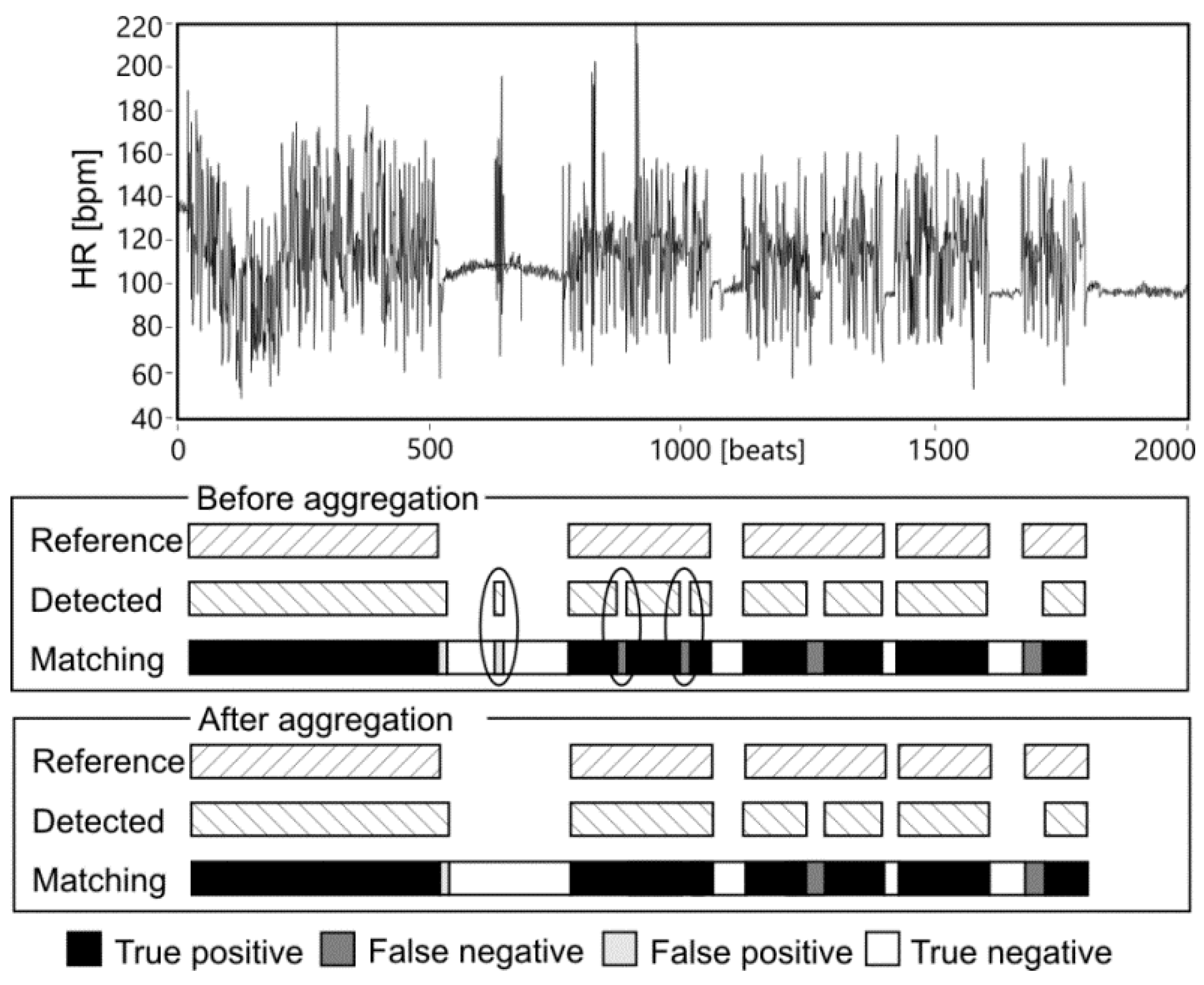
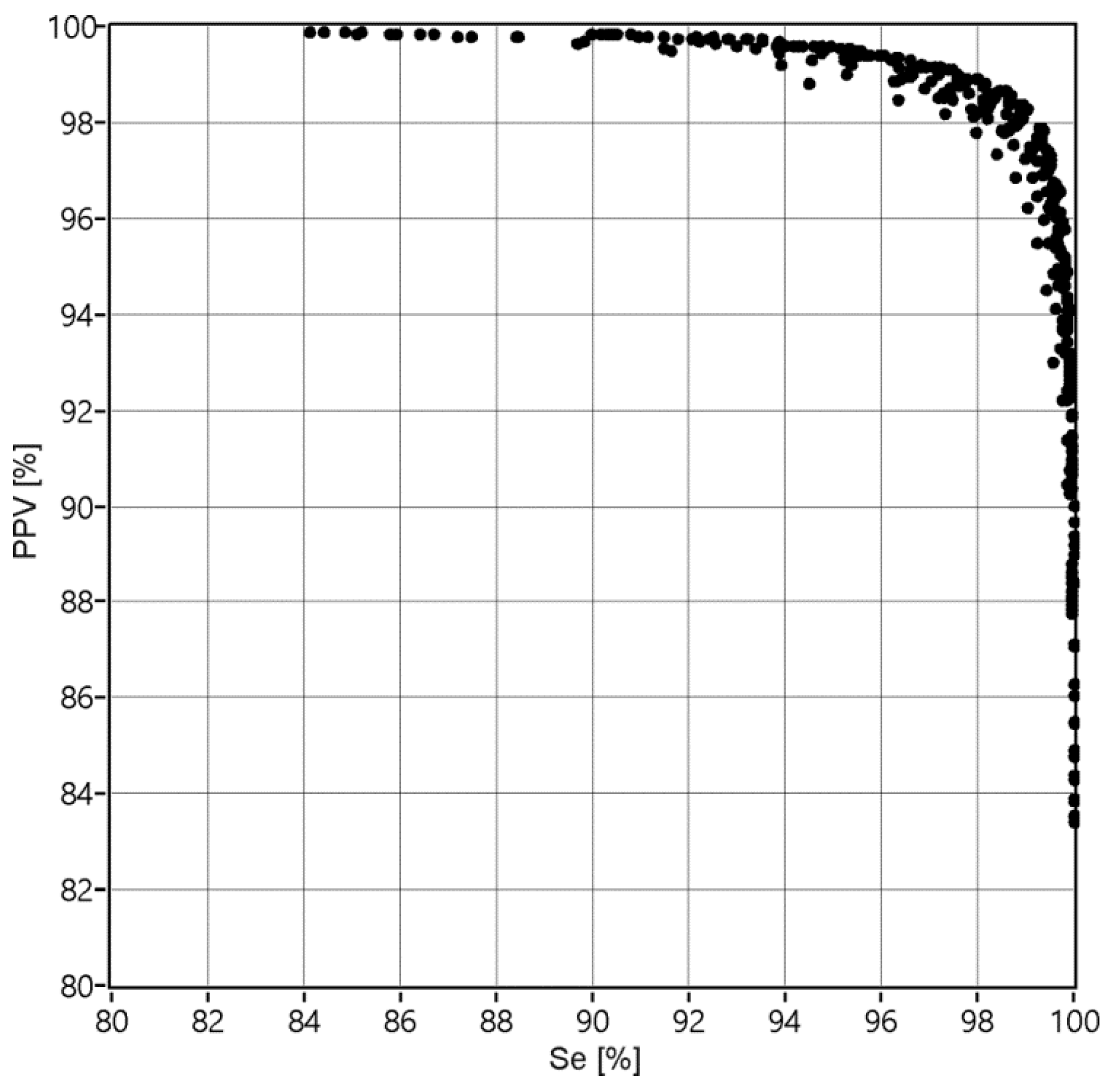
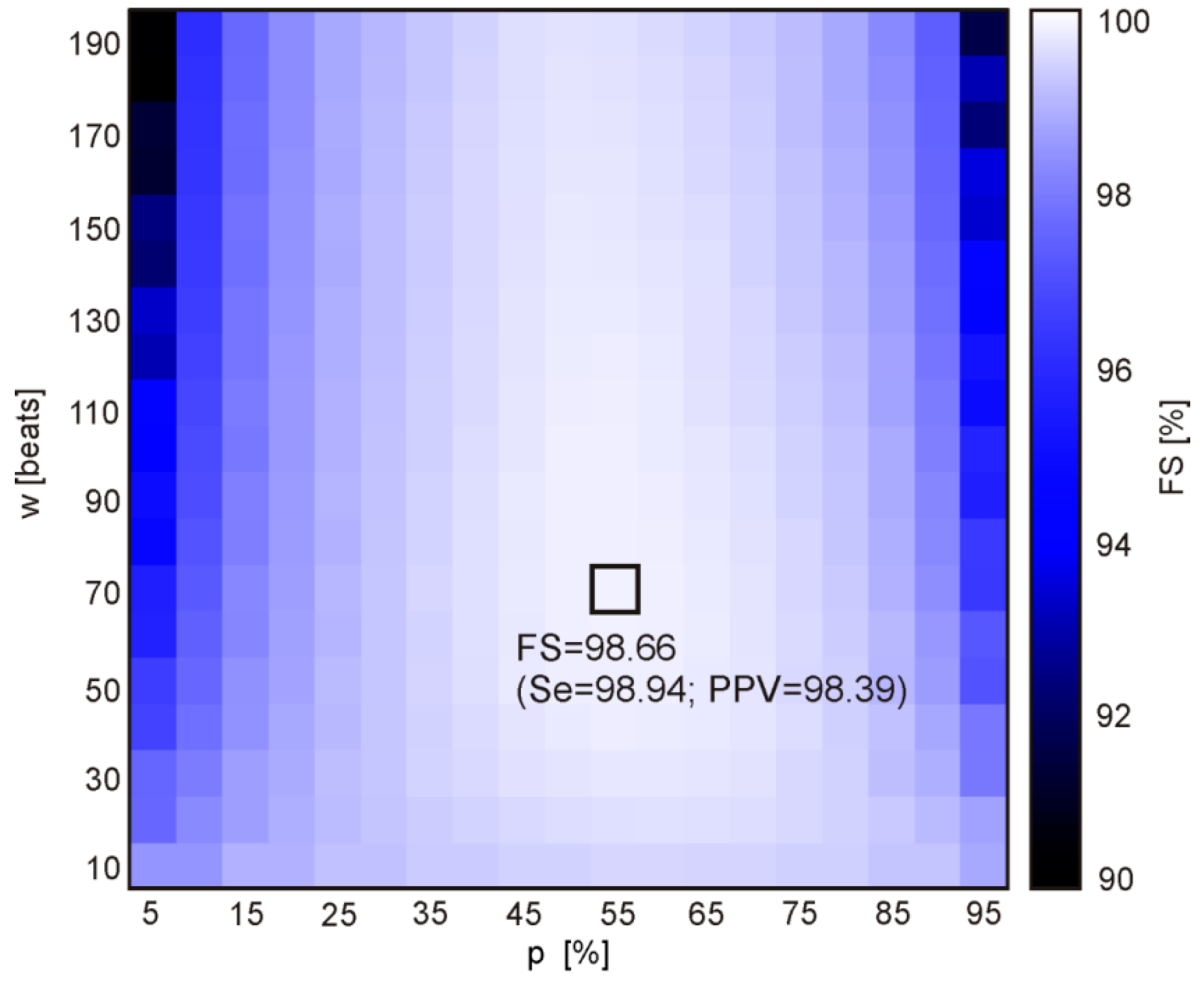
| Signal | |||||||||||||
| 00735 | 03665 | 04015 | 04043 | 04048 | 04126 | 04746 | 04908 | 04936 | 05091 | 05121 | 05261 | 06426 | |
| NAF | 332 | 11057 | 525 | 14634 | 813 | 3293 | 30873 | 5810 | 39681 | 138 | 33759 | 934 | 53115 |
| NnAF | 39880 | 41687 | 43459 | 47260 | 39100 | 39546 | 16979 | 55929 | 13944 | 36634 | 16101 | 44579 | 2019 |
| NAF/NSIG | 0.83% | 20.96% | 1.19% | 23.64% | 2.04% | 7.69% | 64.52% | 9.41% | 74.00% | 0.38% | 67.71% | 2.05% | 96.34% |
| Signal | |||||||||||||
| 06453 | 06995 | 07162 | 07859 | 07879 | 07910 | 08215 | 08219 | 08378 | 08405 | 08434 | 08455 | All | |
| NAF | 445 | 27505 | 39277 | 60245 | 40035 | 6758 | 33118 | 14194 | 11478 | 45083 | 2310 | 44252 | 519664 |
| NnAF | 34371 | 27663 | 0 | 0 | 16538 | 29820 | 10217 | 45078 | 34016 | 13752 | 37519 | 15279 | 701370 |
| NAF/NSIG | 1.28% | 49.86% | 100.0% | 100.0% | 70.77% | 18.48% | 76.42% | 23.95% | 25.23% | 76.63% | 5.80% | 74.33% | 42.56% |
| Signal | NTRN/NALL [%] | Performance Measure [%] | ||||||
|---|---|---|---|---|---|---|---|---|
| CA | Se | Sp | PPV | NPV | FS | FSALL | ||
| 00735 | 0.03 | 93.60 ± 0.53 * | 97.54 ± 0.52 | 90.68 ± 1.10 | 88.60 ± 1.15 | 98.03 ± 0.39 | 92.85 ± 0.54 | 92.85 ± 0.54 |
| 03665 | 0.91 | 81.42 ± 0.42 | 60.55 ± 1.04 | 96.84 ± 0.08 | 93.41 ± 0.13 | 76.87 ± 0.46 | 73.47 ± 0.77 | 73.81 ± 0.76 |
| 04015 | 0.04 | 76.17 ± 1.63 | 48.14 ± 4.20 | 96.93 ± 0.46 | 92.09 ± 0.82 | 71.66 ± 1.62 | 63.12 ± 3.55 | 63.15 ± 3.55 |
| 04043 | 1.20 | 91.47 ± 1.93 | 95.61 ± 1.84 | 88.41 ± 2.95 | 85.99 ± 2.99 | 96.48 ± 1.44 | 90.52 ± 2.01 | 90.63 ± 1.98 |
| 04048 | 0.07 | 89.56 ± 2.69 | 87.37 ± 7.56 | 91.18 ± 1.59 | 88.06 ± 1.46 | 91.01 ± 4.75 | 87.53 ± 3.88 | 87.54 ± 3.88 |
| 04126 | 0.27 | 77.81 ± 1.22 | 51.32 ± 3.02 | 97.42 ± 0.17 | 93.64 ± 0.30 | 73.02 ± 1.20 | 66.25 ± 2.56 | 66.39 ± 2.54 |
| 04746 | 1.39 | 91.55 ± 0.15 | 98.80 ± 0.08 | 86.20 ± 0.27 | 84.08 ± 0.26 | 98.99 ± 0.07 | 90.85 ± 0.14 | 90.99 ± 0.14 |
| 04908 | 0.48 | 92.70 ± 0.72 | 96.64 ± 0.39 | 89.79 ± 1.32 | 87.53 ± 1.42 | 97.31 ± 0.29 | 91.85 ± 0.74 | 91.90 ± 0.74 |
| 04936 | 1.14 | 87.53 ± 0.51 | 91.68 ± 0.36 | 84.47 ± 0.94 | 81.34 ± 0.91 | 93.22 ± 0.26 | 86.20 ± 0.48 | 86.36 ± 0.48 |
| 05091 | 0.01 | 90.29 ± 0.53 | 99.12 ± 0.29 | 83.75 ± 1.07 | 81.89 ± 0.94 | 99.23 ± 0.25 | 89.68 ± 0.49 | 89.68 ± 0.49 |
| 05121 | 1.32 | 87.38 ± 0.66 | 96.21 ± 0.41 | 80.87 ± 1.16 | 78.79 ± 1.02 | 96.66 ± 0.35 | 86.63 ± 0.62 | 86.78 ± 0.61 |
| 05261 | 0.08 | 83.01 ± 2.89 | 64.54 ± 7.01 | 96.70 ± 0.23 | 93.50 ± 0.49 | 78.78 ± 3.28 | 76.17 ± 5.10 | 76.19 ± 5.09 |
| 06426 | 0.17 | 91.84 ± 0.60 | 89.91 ± 0.89 | 93.26 ± 1.05 | 90.83 ± 1.27 | 92.59 ± 0.58 | 90.36 ± 0.66 | 90.38 ± 0.66 |
| 06453 | 0.04 | 92.30 ± 0.83 | 95.70 ± 2.44 | 89.78 ± 1.57 | 87.45 ± 1.55 | 96.63 ± 1.74 | 91.36 ± 1.01 | 91.36 ± 1.01 |
| 06995 | 2.25 | 91.07 ± 0.61 | 86.59 ± 1.44 | 94.37 ± 0.30 | 91.89 ± 0.41 | 90.54 ± 0.92 | 89.15 ± 0.82 | 89.40 ± 0.80 |
| 07879 | 1.35 | 91.16 ± 0.27 | 93.12 ± 0.51 | 89.72 ± 0.29 | 86.98 ± 0.32 | 94.65 ± 0.38 | 89.95 ± 0.31 | 90.10 ± 0.31 |
| 07910 | 0.55 | 88.31 ± 0.87 | 89.04 ± 1.23 | 87.77 ± 1.10 | 84.35 ± 1.23 | 91.55 ± 0.89 | 86.63 ± 0.98 | 86.71 ± 0.97 |
| 08215 | 0.84 | 89.19 ± 0.46 | 96.44 ± 1.00 | 83.84 ± 0.84 | 81.53 ± 0.72 | 96.96 ± 0.81 | 88.35 ± 0.50 | 88.46 ± 0.49 |
| 08219 | 1.16 | 85.99 ± 1.11 | 72.70 ± 2.54 | 95.80 ± 0.55 | 92.75 ± 0.90 | 82.64 ± 1.35 | 81.49 ± 1.70 | 81.76 ± 1.67 |
| 08378 | 0.94 | 91.24 ± 0.27 | 97.58 ± 0.29 | 86.56 ± 0.47 | 84.29 ± 0.45 | 97.98 ± 0.23 | 90.45 ± 0.28 | 90.55 ± 0.27 |
| 08405 | 1.13 | 94.22 ± 0.19 | 96.11 ± 0.47 | 92.82 ± 0.28 | 90.81 ± 0.30 | 97.00 ± 0.35 | 93.39 ± 0.22 | 93.47 ± 0.22 |
| 08434 | 0.19 | 92.81 ± 0.39 | 97.37 ± 0.51 | 89.44 ± 0.64 | 87.23 ± 0.66 | 97.87 ± 0.40 | 92.02 ± 0.42 | 92.04 ± 0.42 |
| 08455 | 1.25 | 92.99 ± 0.21 | 97.73 ± 0.19 | 89.49 ± 0.39 | 87.28 ± 0.40 | 98.16 ± 0.15 | 92.21 ± 0.22 | 92.32 ± 0.21 |
| Training Data Selection | Performance Measure [%] | |||||
|---|---|---|---|---|---|---|
| Se | Sp | PPV | NPV | FS | CA | |
| Testing data only | ||||||
| TD1 | 96.11 ± 0.47 * | 92.82 ± 0.28 | 90.81 ± 0.30 | 97.00 ± 0.35 | 93.39 ± 0.22 | 94.22 ± 0.19 |
| TD2 | 95.63 ± 0.76 | 92.43 ± 0.29 | 90.31 ± 0.31 | 96.64 ± 0.56 | 92.89 ± 0.36 | 93.79 ± 0.30 |
| TD3 | 82.53 ± 0.94 | 95.19 ± 0.17 | 92.68 ± 0.22 | 88.08 ± 0.56 | 87.31 ± 0.53 | 89.82 ± 0.37 |
| TD4 | 98.12 ± 0.08 | 97.31 ± 0.09 | 96.42 ± 0.11 | 98.60 ± 0.06 | 97.26 ± 0.04 | 97.65 ± 0.04 |
| All the database | ||||||
| TD1 | 96.17 ± 0.46 | 92.89 ± 0.27 | 90.93 ± 0.30 | 97.03 ± 0.34 | 93.47 ± 0.22 | 94.28 ± 0.19 |
| TD2 | 95.70 ± 0.74 | 92.52 ± 0.28 | 90.46 ± 0.31 | 96.68 ± 0.55 | 93.00 ± 0.36 | 93.87 ± 0.29 |
| TD3 | 82.81 ± 0.92 | 95.25 ± 0.16 | 92.82 ± 0.21 | 88.21 ± 0.55 | 87.53 ± 0.52 | 89.96 ± 0.37 |
| TD4 | 98.14 ± 0.08 | 97.34 ± 0.09 | 96.47 ± 0.11 | 98.61 ± 0.06 | 97.30 ± 0.04 | 97.68 ± 0.04 |
| Training Data Selection | Performance Measure [%] | |||||
|---|---|---|---|---|---|---|
| Se | Sp | PPV | NPV | FS | CA | |
| Testing data only | ||||||
| TD1 | 91.04 ± 1.75 * | 93.61 ± 0.34 | 91.34 ± 0.41 | 93.42 ± 1.20 | 91.18 ± 0.91 | 92.52 ± 0.71 |
| TD2 | 91.90 ± 1.30 | 92.64 ± 0.40 | 90.21 ± 0.48 | 93.95 ± 0.91 | 91.04 ± 0.72 | 92.32 ± 0.58 |
| TD3 | 82.08 ± 1.13 | 95.17 ± 0.20 | 92.62 ± 0.25 | 87.81 ± 0.67 | 87.03 ± 0.64 | 89.61 ± 0.45 |
| TD4 | 97.97 ± 0.09 | 97.02 ± 0.10 | 96.04 ± 0.12 | 98.48 ± 0.07 | 96.99 ± 0.05 | 97.42 ± 0.04 |
| All the database | ||||||
| TD1 | 91.16 ± 1.73 | 93.68 ± 0.34 | 91.44 ± 0.40 | 93.48 ± 1.19 | 91.29 ± 0.90 | 92.61 ± 0.70 |
| TD2 | 92.03 ± 1.28 | 92.73 ± 0.39 | 90.37 ± 0.47 | 94.02 ± 0.90 | 91.12 ± 0.71 | 92.43 ± 0.57 |
| TD3 | 82.37 ± 1.12 | 95.23 ± 0.19 | 92.76 ± 0.25 | 87.95 ± 0.66 | 87.25 ± 0.63 | 89.76 ± 0.45 |
| TD4 | 97.99 ± 0.09 | 97.04 ± 0.10 | 96.10 ± 0.12 | 98.49 ± 0.07 | 97.02 ± 0.05 | 97.44 ± 0.04 |
| Performance Measures [%] | No Aggregation | With Aggregation |
|---|---|---|
| Se | 98.10 | 98.94 |
| Sp | 97.50 | 98.80 |
| PPV | 96.67 | 98.39 |
| NPV | 98,57 | 99,21 |
| CA | 97.75 | 98.86 |
| FS | 97.38 | 98.66 |
| Method | Features | Window | Key Techniques | Results | |||
|---|---|---|---|---|---|---|---|
| Se | Sp | PPV | CA | ||||
| Tateno et al. 2001 [33] | RR difference | 100 beats | Histogram, Kolmogorov-Smirnov test, ROC. | 94.4 | 97.2 | 96.1 | – |
| Huang et al. 2011 [74] | RR difference | 23 beats | Histogram, SD analysis, Kolmogorov-Smirnov test. | 96.1 | 98.1 | – | – |
| Petrucci et al. 2005 [34] | RR difference, RR prematurity | 60 s | Geometric measures of histogram, Score system. | 92 | – | 92 | – |
| Lian et al. 2011 [35] | RR interval, RR difference | 128 beats | Mapping RR intervals versus RR differences, thresholds. | 95.8 | 96.4 | – | – |
| Petrenas et al. 2015 [44] | RR interval | 8 beats | Thresholds | 97.1 | 98.3 | – | – |
| Logan et al. 2005 [29] | RR interval | 600 beats | Variance of normalized RR interval, simple majority voting. | 96 | 89 | – | – |
| Islam et al. 2016 [30] | RR interval | 70 beats | Normalization of RR intervals by an affine transformation. | 96.39 | 96.38 | 95.19 | 96.38 |
| Babaeizadeh. et al. 2009 [16] | RR interval P-wave measurements | - | Stationary first-order Markov process, decision tree. | 94 | 99 | 98 | – |
| Zhou et al. 2014 [36] | RR interval | 127 beats | Mapping the RR sequence into symbolic one, Shannon entropy, ROC. | 96.89 | 98.25 | 97.62 | 97.67 |
| Zhou et al. 2015 [75] | RR interval | 127 beats | Online version of [36] | 97.37 | 98.44 | 97.89 | 97.99 |
| Cui et al. 2017 [37] | RR interval | 150 beats | Mapping the RR sequence into symbolic one, dissimilarity index. | 97.04 | 97.96 | – | 97.78 |
| Dash et al. 2009 [38] | RR difference | 128 beats | Turning points, RMSSDD, Shannon entropy, ROC. | 94.4 | 95.1 | – | – |
| Lake et al. 2011 [15] | RR difference | 12 beats | Coefficient of sample entropy (CoSEn), ROC. | 91 | 94 | – | – |
| Kennedy et al. 2016 [32] | RR difference | 30 beats | Random forest, k-nearest neighbor. | 97.6 | 98.3 | 92.1 | – |
| Andersen et al. 2017 [39] | RR interval ECG features | 300 beats 30 s | Sample entropy, Shannon entropy, CoSEn, SVM. | 96.81 94.27 | 96.20 98.84 | – | 96.45 96.68 |
| Kumar et al. 2018 [76] | ECG features | 1000 samples | Wavelet transform, Random forest. | 95.8 | 97.8 | – | 96.8 |
| Nuryani et al. 2015 [40] | RR difference | SVM with radial basis function. | 95.81 | 98.44 | – | 97.50 | |
| Colloca et al. 2013 [41] | RR difference Median HR | 30 | Entropy, SVM with radial basis function | 99.20 | - | 59.33 | 86.60 |
| Faust et al. 2018 [46] | - | 100 | Deep Recurrent Neural Network (RNN) with Long Short-Term Memory (LSTM). | 98.51 | 98.32 | – | 98.67 |
| Andersen et al. 2019 [45] | - | 31 | Deep learning combining with the convolutional- and Recurrent-Neural Networks. | 98.98 | 96.95 | 95.76 | 97.80 |
| Wrobel et al. 2018 [53] | HR irregularity features | 21 | Linear classifier | 95.42 | 96.12 | 94.97 | 95.62 |
| Proposed method 2019 | HR irregularity features | 21 | LSVM | 98.94 | 98.39 | 98.86 | 98.66 |
© 2020 by the authors. Licensee MDPI, Basel, Switzerland. This article is an open access article distributed under the terms and conditions of the Creative Commons Attribution (CC BY) license (http://creativecommons.org/licenses/by/4.0/).
Share and Cite
Czabanski, R.; Horoba, K.; Wrobel, J.; Matonia, A.; Martinek, R.; Kupka, T.; Jezewski, M.; Kahankova, R.; Jezewski, J.; Leski, J.M. Detection of Atrial Fibrillation Episodes in Long-Term Heart Rhythm Signals Using a Support Vector Machine. Sensors 2020, 20, 765. https://doi.org/10.3390/s20030765
Czabanski R, Horoba K, Wrobel J, Matonia A, Martinek R, Kupka T, Jezewski M, Kahankova R, Jezewski J, Leski JM. Detection of Atrial Fibrillation Episodes in Long-Term Heart Rhythm Signals Using a Support Vector Machine. Sensors. 2020; 20(3):765. https://doi.org/10.3390/s20030765
Chicago/Turabian StyleCzabanski, Robert, Krzysztof Horoba, Janusz Wrobel, Adam Matonia, Radek Martinek, Tomasz Kupka, Michal Jezewski, Radana Kahankova, Janusz Jezewski, and Jacek M. Leski. 2020. "Detection of Atrial Fibrillation Episodes in Long-Term Heart Rhythm Signals Using a Support Vector Machine" Sensors 20, no. 3: 765. https://doi.org/10.3390/s20030765
APA StyleCzabanski, R., Horoba, K., Wrobel, J., Matonia, A., Martinek, R., Kupka, T., Jezewski, M., Kahankova, R., Jezewski, J., & Leski, J. M. (2020). Detection of Atrial Fibrillation Episodes in Long-Term Heart Rhythm Signals Using a Support Vector Machine. Sensors, 20(3), 765. https://doi.org/10.3390/s20030765






